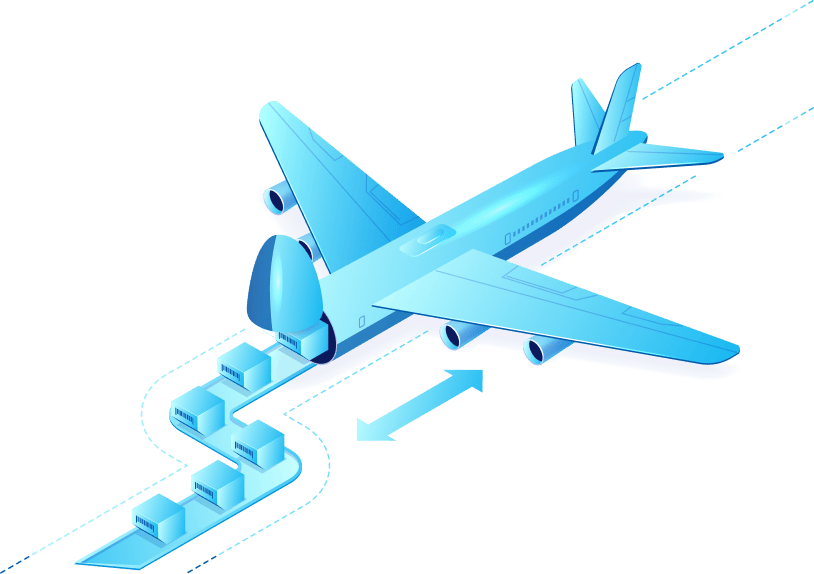Air Freight to China
Air Freight to China
Fast, Reliable, and Efficient Air Freight to/from China
DFreight Air Freight Service is your top choice for swift and dependable air cargo shipping to/from China. For a variety of commodities, including perishable goods, healthcare supplies, electronics, machinery, or anything that demands fast delivery from China to the UAE and vice versa, we’ve got you covered. With years of expertise, comprehensive solutions, a commitment to on-time delivery, cutting-edge technology, top-notch security, competitive pricing, and a global reach, we’re here to make your airfreight experience seamless and worry-free. Trust DFreight for excellence in air shipping and submit your inquiry right away to receive the best competitive prices for your air cargo to/from China.

China Exports and
Imports
The top exports of China are Broadcasting Equipment, Computers, Integrated Circuits, Office Machine Parts, and Telephones, exporting mostly to United States, Japan, South Korea, and Germany.
The top imports of China are Crude Petroleum, Integrated Circuits, Iron Ore, Petroleum Gas, and Copper Ore, importing mostly from South Korea, Japan, United States, Australia, and Chinese Taipei.
Market Update
According to OEC, in 2021, China was the number 2 economy in the world in terms of GDP, the number 1 in total exports, the number 2 in total imports, the number 58 economy in terms of GDP per capita and the number 25 most complex economy according to the Economic Complexity Index.
China exported US$43.82 Billion during 2021 to the United Arab Emirates and imported US$28.57 Billion during 2021 from the UAE, according to the Trading Economics database.
China and the UAE freight market are expected to experience significant growth in 2023. This increase is largely due to the rise in trade and investment between the two countries, as well as the growing demand for air freight services. The UAE is an important gateway for Chinese goods as it provides direct access to markets in the Middle East, Africa, and Europe. Additionally, the Chinese government is investing heavily in the infrastructure needed to facilitate increased levels of trade. As a result, the UAE and China are likely to remain important players in the global freight market for years to come.
Banned Products
Importing certain products into China is strictly prohibited due to the country‘s import regulations. These banned products include weapons, counterfeit products, hazardous waste, endangered species, and foodstuffs that do not meet China’s food safety standards. All imports into China must be accompanied by an approved Chinese import permit, and any shipments of banned products are subject to seizure and confiscation by Chinese customs authorities. Failure to follow regulations can result in fines, loss of product, or even criminal prosecution. Companies wishing to import goods into China should always check with customs authorities to ensure that their products do not fall into the banned category.


Documents & Customs Clearance
One thing to take into account when exporting cargo internationally is customs clearance. You must be aware of the customs clearance regulations of the destination countries when shipping cargo from China.
The following documentation must be given to local customs for international shipments by the supplier, consignee, or intermediary:
– A commercial invoice
– A packing list
– A bill of lading
– A certificate of origin
Shipping Different Commodities from/to China
How to Ship Frozen Food: An Ultimate Guide
How to Ship Musical Instruments
Major Air Cargo Port
-
Italy
Germany
United Kingdom
Netherlands
France
Turkey
Spain
Denmark
Switzerland
Czech Republic
Hungary
Poland
Romania
Greece
Portugal
Slovakia
Sweden
Ireland
-
China
India
Taiwan
Hong Kong
Japan
Singapore
South Korea
Malaysia
Qatar
Indonesia
Saudi Arabia
Thailand
Bangladesh
Lebanon
Kuwait
-
Uganda
Congo
Egypt
Rwanda
Kenya
South Africa
Morocco
Algeria
-
-
-


We consolidate cargo from Germany, Belgium, France, Luxembourg, and nearby cities to Amsterdam, then ship it directly to Dubai.
Certificates & Memberships




- Stress-Free Documentation We simplify the paperwork process, making it easy for you to focus on what matters most – your shipment.
- Clear Cost Breakdown Our pricing is straightforward, with a detailed breakdown so you can see exactly where your money goes.
- Dedicated Support We’re just a click away. Your dedicated support team is there to address any questions or concerns promptly.
- Live Shipment Tracking Easily follow your ocean and air freight shipments 24/7 with real-time tracking. No more unexpected delays.
Ship Your Cargo with Ease
Get Started Today!
Why Choose Consolidated Air Freight?
Guaranteed Space
Secure your cargo space without worries.
Reliable Scheduling
Count on our reliable predictive schedules
Nationwide Collections
We pick up your cargo throughout Benelux and Germany
Regional Trucking
Benefit from local trucking within Europe and GCC
Competitive Pricing
Enjoy market-competitive air freight rates
Fast Delivery
Rapid and secure shipping for time-sensitive items
Regional Trucking
Benefit from local trucking within Europe and GCC
Competitive Pricing
Enjoy market-competitive air freight rates
Fast Delivery
Rapid and secure shipping for time-sensitive items
Guaranteed Space
Secure your cargo space without worries.
Reliable Scheduling
Count on our reliable predictive schedules
Nationwide Collections
We pick up your cargo throughout Benelux and Germany
Any Questions?
Reach out to us, and our experts will work with you to discover the tailored solution you need.





 Germany
Germany Netherlands
Netherlands Luxemburg
Luxemburg Belgium
Belgium





